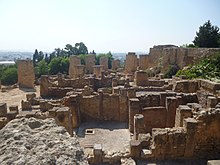
Tunisia

The Numidians and Moors belonged to the race from which the Berbers are descended. The translated meaning of Numidian is Nomad and indeed the people were semi-nomadic until the reign of Masinissa of the Massyli tribe.
At the beginning of recorded history, Tunisia was inhabited by Berber tribes. Its coast was settled by Phoenicians starting as early as the 12th century BC (Bizerte, Utica). The city of Carthage was founded in the 9th century BC by Phoenicians. Legend says that Dido from Tyre, now in modern-day Lebanon, founded the city in 814 BC, as retold by the Greek writer Timaeus of Tauromenium. The settlers of Carthage brought their culture and religion from Phoenicia, now present-day Lebanon and adjacent areas.
After the series of wars with Greek city-states of Sicily in the 5th century BC, Carthage rose to power and eventually became the dominant civilization in the Western Mediterranean. The people of Carthage worshipped a pantheon of Middle Eastern gods including Baal and Tanit. Tanit’s symbol, a simple female figure with extended arms and long dress, is a popular icon found in ancient sites. The founders of Carthage also established a Tophet, which was altered in Roman times.

Following the Battle of Carthage which began in 149 BC during the Third Punic War, Carthage was conquered by Rome in 146 BC. Following its conquest, the Romans renamed Carthage to Africa, incorporating it as a province.

By the 2nd century, olive oil rivaled cereals as an export item. In addition to the cultivations and the capture and transporting of exotic wild animals from the western mountains, the principal production and exports included the textiles, marble, wine, timber, livestock, pottery such as African Red Slip, and wool.
There was even a huge production of mosaics and ceramics, exported mainly to Italy, in the central area of El Djem (where there was the second biggest amphitheater in the Roman Empire).
Berber bishop Donatus Magnus was the founder of a Christian group known as the Donatists. During the 5th and 6th centuries (from 430 to 533 AD), the Germanic Vandals invaded and ruled over a kingdom in Northwest Africa that included present-day Tripoli. The region was easily reconquered in 533–534 AD, during the rule of Emperor Justinian I, by the Eastern Romans led by General Belisarius.
